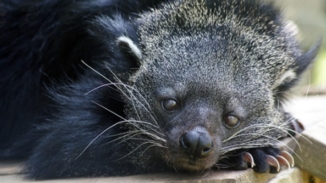
爆米花味的熊狸
Bearcats Naturally Pass the Popcorn
爆米花味的熊狸
Researchers have uncovered the chemistry that makes the urine of bearcats smell like freshly cooked popcorn.
科学家发现了使熊狸(bearcat)尿液闻上去像新鲜爆米花的化合物。
播音/撰文 凯伦·霍普金(Karen Hopkin o)
翻译 Meatle
审校 乔虹
统筹 李轩
Chances are you’ve never seen a binturong. It’s a tree-dwelling mammal about the size of a raccoon that’s native to Southeast Asia. But if you’ve ever been to the movies, you’d be familiar with their scent. That’s because binturongs smell like freshly cooked popcorn. And now, in a major advance in research connecting animal odors to human recreational venues, researchers know why.
你可能从未见过熊狸。它是一种原产于东南亚,居住在树上,大小与浣熊相仿的动物。但如果你去过电影院的话,就会对它们的气味感到熟悉,因为熊狸闻起来就像新鲜出炉的爆米花。现在,一项将动物气味与人类休闲场所联系在一起的研究,解开了熊狸气味的奥秘。
In the wild, binturongs, also called bearcats, are thought to spend most of their time alone. So to communicate with potential mates—or rivals—they leave behind aromatic messages. Although to you and me their musk evokes a matinee, to other animals it reads pure binturong. But previous studies of the animals’ scent glands failed to find chemicals that could account for the distinctive stank. Desperate for an answer, the researchers opted to peruse some pee.
人们普遍认为,在野外,熊狸长时间处于独处状态。为了吸引伴侣或是驱逐竞争对手,它们会留下香味信息。尽管这些气味可能会引起人们的观影记忆,但对于其他动物来说,这只是熊狸留下的一种气味。然而过往的研究从未在熊狸的香味腺体中发现与这种气味相关的化学物质。为了找到真相,研究人员开始着眼于熊狸的尿液。
They ever-so-gently squeezed 33 sedated binturongs at a North Caroline wildlife sanctuary to produce urine for analysis. And they discovered that the samples contained a compound called 2-acetyl-1-pyrroline, or 2-AP—which is the very same chemical that lends its distinctive scent to popcorn, as well as to some rice and breads. The finding is served up in the journal Naturwissenschaften, or The Science of Nature. [Lydia K. Greene et al, Reproductive endocrine patterns and volatile urinary compounds of Arctictis binturong: discovering why bearcats smell like popcorn]
在北卡罗纳野生动物保护区(North Caroline wildlife sanctuary),他们相当温柔地从33只被镇静的熊狸身上采集尿液进行分析。他们发现这些样本含有2-乙酰基-1-吡咯啉,或2-AP。2-AP同样存在于米与面包之中,这正是使熊狸闻起来像爆米花的化合物。该项研究发表在《自然科学期刊》(Naturwissenschaften, 或The Science of Nature)。
Popcorn gets its 2-AP from the Maillard reaction, chemistry that occurs as corn kernels heat up. But for bearcats, who don’t have access to an air popper, it’s probably the bacteria present on their fur or in their intestines that help cook up their signature scent—the researchers confirmed that the animals don’t get their 2-AP from their diet, which, in captivity, includes kibbles and mice.
爆米花是通过美拉德反应(Maillard reaction)生成2-AP,该反应会在玉米粒受热后发生。但对于熊狸,它们的气味与热风爆米花机无关,而与它们皮毛和肠胃中的微生物群有关。这些微生物炮制了这种气味——研究人员通过改变熊狸的饮食,包括分别投喂粗粮与老鼠,确认熊狸并不是通过它们的饮食方式获得2-AP。
When binturongs go wee, they tend to soak their tails and feet, which ensures that they leave behind a trail of odiferous information about their species, sex, and reproductive readiness. Of course, if you find yourself in binturong country, remember: that ain’t popcorn you smell. So don’t lick your fingers.
熊狸在尿尿的时候,会将自己的尾巴和脚浇湿,从而确保它们能够留下关于它们的种群、性别和生育欲望的一系列气味信息。当你处于熊狸的国度,请记得:你闻到的不是爆米花的气味!所以不要吮手指了。
未经书面许可任何人不得复制或镜像
京ICP备11000850号-1
 京公网安备11010502039775号
京公网安备11010502039775号 信息网络传播视听节目许可证0111611号
国家科技基础条件平台

















